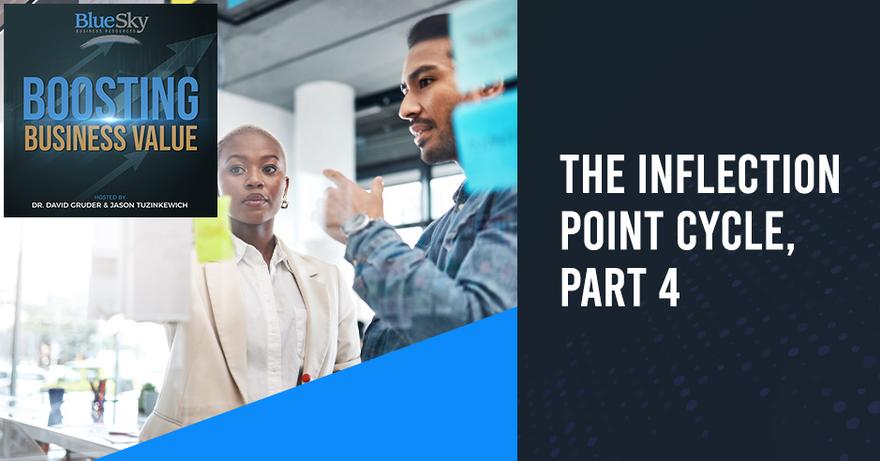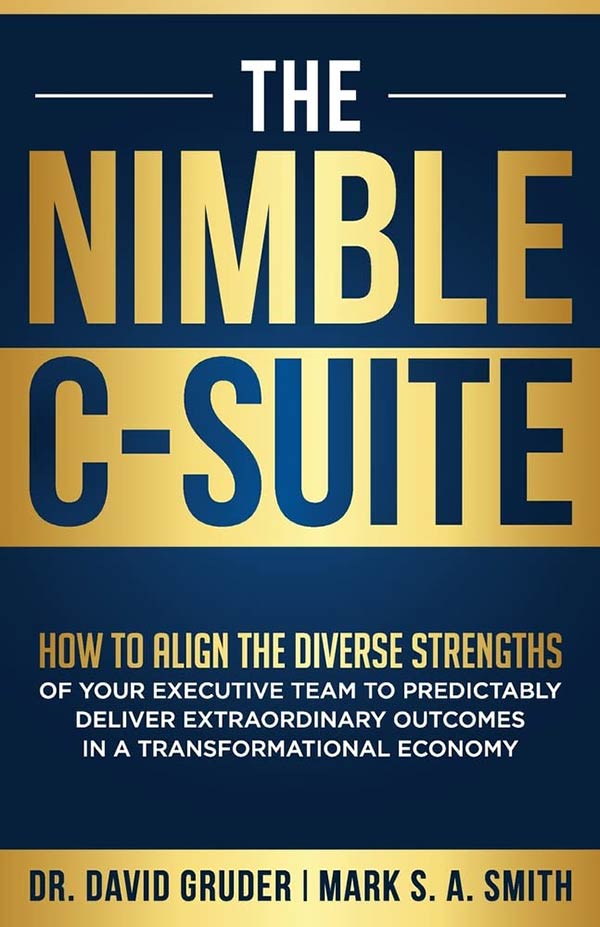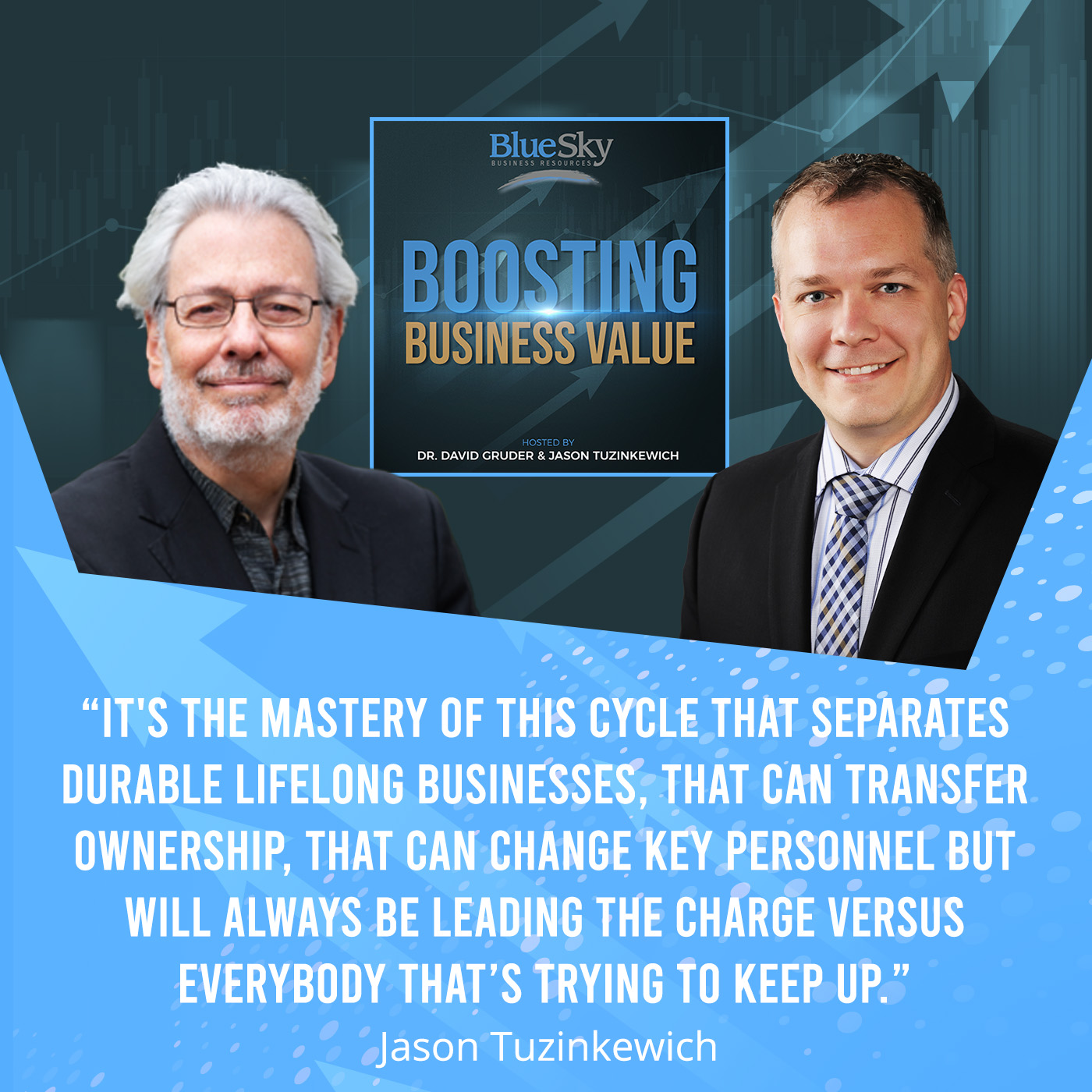Ep. 28 - The Inflection Point Cycle, Part 4

There are three "Inflection Points" that businesses must master to maintain durability, elevate long-term growth and value, and enjoy fruitful exits: Innovation, Fruition, and Bifurcation. In the conclusion of our four-part mini-series on "The Inflection Point Cycle," we're discussing the last and most critical phase: the Bifurcation Phase – a business's ultimate test of adaptability, resilience, and vision. We’ve discussed the Innovation Phase, where groundbreaking ideas take shape, and the Fruition Phase, where consistency reigns supreme. Now, it's time to explore the period of ambidexterity, in which a business develops its next innovation while continuing scale fruition with its current innovation. Discover why this phase is often the make-or-break moment for businesses. This episode delves into the crucial and frequently overlooked details for successfully navigating your company's Bifurcation phase in ways that deepen durability, boost business value, and build exit-readiness. Tune in now to unlock the keys to mastering the Bifurcation Phase and securing your business's place in the annals of success.
---
Watch the episode here
Listen to the podcast here
The Inflection Point Cycle, Part 4
Successfully Navigating Your Business's Third Inflection Point: The Bifurcation Phase – Your Key To Preventing Obsolescence And Boosting Business Value
This episode is the final part of our miniseries on the three inflection points that all businesses must master to achieve durability and long-term growth. In this final episode of this miniseries, we're going to be diving into the third inflection point, which is the bifurcation phase. We'll go into all the details of that in a moment. It’s great to be back with you.
Thank you so much. It’s good to be back with you as well. Let's do a little bit of backing up before we start driving this bus forward because this is going to be a meaty one. Let's go back to what are we talking about when we're talking about inflection points that are universal to businesses. When we think about inflection points, what we're really talking about are major functional pivot points. This is where strategy organization tactics and leadership style requirements are forced to change in order for the organization to make the next big leap forward. This is a perpetual cycle.
Each of these inflection points in a durable, longstanding business is going to come up again and again. You'll see in this episode that this bifurcation is where we split inflection point two going into fruition apart and let that start to run its life out as we move into the other inflection point of innovation for the new cycle to begin. These inflection points, as another quick catch-up, start with innovation, we move into fruition, and then we go to this bifurcation or ambidextrous portion of the cycle when you're doing both at once. Eventually, the product or service that you have in fruition will begin to twilight and the innovation will replace with what's next.
The heart of what happens during the bifurcation phase is that this is when you're creating value, durability, and hence, saleability. It's an important phase because when companies rest on their laurels with their last innovation or their 1st innovation and they never get beyond the 1st innovation, they will become dinosaurs. It's not a matter of if that will happen. The only question is how long it is going to take for them to become dinosaurs.
Unfortunately, there's a graveyard of companies that reached fruition with their initial or subsequent innovation and didn't go into bifurcation. They stayed in the fruition phase and ended up going out of business or getting acquired in a hostile takeover. That's exactly what a durable business takes very specific steps to prevent. The bifurcation phase is when those steps are taken.
I appreciate that. Bifurcation is the hardest phase of running a business. In the previous episodes, we talked about an innovator who has difficulty and may not even have the right skillsets to lead an operation that's in fruition. The great leaders and operators of fruition are typically not the best innovators. You need an executive team that can do both. This is really tricky. This is why so many organizations die when it's time to bifurcate because it's so hard.
Let's talk about some of the reasons why this is challenging. Each portion of the attention in bifurcation requires a different management and operational style. In fruition, this is all about consistency. It's all about continuity. It's all about a steady state of operation that churns out top-quality, consistent products or services time and time again. Whereas the innovation phase is all about change. It's all about failing forward and making smart decisions based on this change, adaptability, and failure. These are as polar opposites as they can be in leadership style requirements and organizational structure requirements.
For the portion of the business that is in fruition, it needs to stay focused on earning profits and putting out a consistently high-quality product. The portion of the business that is going into innovation needs to have the freedom to not have the same constraints, the same KPIs, and the same expectations of profitability and consistency that the going concern has. On the surface, that sounds pretty easy. The problem is if you separate them too much, then the innovation team will be starved of all the resources that make this business successful.
We want to make sure that as we're leading this bifurcation, we're separating them enough that both operations have the ability to perform in a way that will drive towards success but not so much that the resources, the strength, and the value intrinsic to the organization are cut off from the innovating future of the company.
What you've captured perfectly is the nature of the ambidexterity that is central to the bifurcation phase. The ambidexterity that the C-Suite or the top executive team in the business have to grow into having for this phase or if there are individuals for whom growing into that is beyond their capabilities or beyond their interest levels. No harm, no shame, no fault, and no blame. It's time to replace them.
That is something that is part of what's hard throughout all of these inflection points. CEOs, founders, and other chief executives in an organization, their responsibility is to continually become who the business needs them to be in order for it to succeed in its phase or they need to get out of the way. Their time has come and gone. I don't mean that and neither do you as a criticism. It's a matter of personal interest, personal capabilities, personal taste, and personal passions.
CEOs, Founders, and other Chief Executives in an organization, their responsibility is to continually become who the business needs them to be in order for it to succeed in its current phase. Otherwise, they need to get out of the way.
Some people are wired to continually become who the business needs them to be as the business evolves, grows, and matures and others are not. You and I know, for example, some people whose superpower is being a turnaround CEO. I would never try to turn them into something that's more flexible or ambidextrous that is growing as the business grows. That's their sweet spot, and they're brought in at the right point, hopefully.
Once the turnaround is accomplished, they leave. They're an interim CEO for the purpose of turnaround. It’s important to me that we underscore the importance of this not being a matter of being judgmental. It's a matter of right matching. Some people are in their sweet spot in a specific phase of an organization's development.
If that's you, let it be you. Knowing that means that there's a time when your sweet spot comes on board as being optimally right-matched for a business development phase. There's going to be a time when you succeed with your superpower and you will be replaced by someone who is better suited for the next phase in the business's development. If that's you, let it be you. If it's you to be in constant kaizen as a leader, let that be you. It's all good. Be conscious, be aware, and be responsible for what's true for you.
When you're building the executive team with these inflection points in mind, you can start to think about the length of these phases within the cycle. I've seen businesses that have fast cycles. They're constantly innovated. You think about products in the tech center. Typically, you'll see an executive team with a CEO-COO partnership. It is where one of them is the great fruition leader and the other one is the great innovation leader and they pass the baton between each other. Don't expect one person to be equally exceptional at innovation and fruition. We all have our strengths and weaknesses, but we can build a team where we can feed one another.
Don't expect one person to be equally exceptional at innovation and at fruition. We all have our strengths and weaknesses, but we can build a team where we can feed one another.
It's the team that needs to be ambidextrous, not necessarily every single member of the team. Let’s go into detail about the innovation adjustments during bifurcation. You've already covered some of this. The autonomy, freedom, and entrepreneurship that the innovation group in the bifurcation phase needs to have and requires freedom from the KPIs that are used by the fruition folks, the metrics, the salary criteria, and all of those because they're back in the innovation phase with whatever is next for that business development. That’s important to be aware of and to implement.
It's also not identical to the 1st phase, the 1st inflection point, or the innovation phase in that in the bifurcation phase, innovation requires being more discerning about what you do and don't develop as the next innovation. If you develop an innovation that requires you to, for example, shift your whole focus on the customers or clients that you serve, that's going to be an uphill struggle. Whereas if your next innovation is an innovation that the market you already serve is looking for next, that's more efficient generally. That leads to appreciating that innovation during the bifurcation phase can't be divorced from the overall company's functioning.
If it is divorced and they go off completely siloed or fully siloed on their own, then what inevitably will emerge is resentment, poor buy-in, internal sabotage, and fiscal challenges that should and could have been avoided if this version of innovation was handled right. What that ends up leading to is internal losers inside the business. This is all by way of saying that this is another aspect of why innovation during the bifurcation phase is not identical to innovation during the phase 1 inflection point, the 1st phase, or the innovation phase.
In being ambidextrous, because you're doing both fruition and innovation of the next thing during the bifurcation phase, the matrix communication or your communication framework can be challenging because it's more complicated. You're doing two focuses at once. That also makes human resource management more complicated.
In the context of this episode, we're not going to go into all of the ins and outs of how human resource management becomes more complicated. It's crucial to be aware of that and then make sure that your HR people are literate in how to manage human resources during a bifurcation phase. If your HR folks are not literate in that, they may need to be replaced or they need to be up-leveled in their skillsets to deal with human resource management challenges that are specific to the bifurcation phase.
I want to build on that in a couple of ways because it occurs to me there are going to be a lot of business teams that are tuning in to our episodes and being like, “We've got an R&D department. They do great. Why are you wasting all this time on R&D and calling it bifurcation? We know what we're doing.” I'd like to caution you.
Kodak had an exquisite R&D department. As a matter of fact, Kodak developed the first digital camera in their R&D department, but they were no longer a bifurcation-capable organization. They weren't able to bring the innovation that ultimately changed the world of photography to life in a meaningful way. We all know what happened to them because of that. This bifurcation into agility is taking what R&D comes up with, building a business case around it, and bringing that business case to life to the point where it can be turned into fruition or profit. It’s important to keep in mind that these are different things and different beasts.
In what you were saying about the human resource element of being bifurcated, you're so right. When you're starting a startup, you have to build all the bones of a business in order to bring your product or service to life. When you're bifurcating inside an organization, a lot of those bones would be redundant. There’s the payroll department and the cost accounting department. There are all these different divisions, even production lines.
If you're creating products, you don't want to build a manufacturing line until you know that your product is viable and that your business case is viable. There's this requisite sharing where the innovators have to pull resources, whether that's human resources, production time, or service time from the fruition organization. This is where the fruition side has to make adjustments, too, because this is the camp in the business that loves consistency. They love the status quo. They are happy doing the exact same thing every day and we're asking them to change a little bit.

That part is hard because you've got normal employees who now have 2 masters, but 1 of their masters has a known, proven, and well-understood compensation package that pertains to your ability to pay attention to that master. Those are your performance metrics, your output, your quality metrics, or whatever it is. This other new, different master is asking you to sacrifice your bonus to support them for what? To interrupt my status quo?
On the fruition side of the company, you have to create new incentives and new structures to make it appropriate for these people to change their operations and to sacrifice one KPI in order to benefit another one without sacrificing their quality of work and the consistency of their income. That's something that is tricky on the fruition side.
The other thing on the fruition side is paying for innovation. Innovation, by definition, is not generating revenue. When you've got a successful fruition side, it's possible for the innovation team to feel like they have a blank check and to fall in love with an idea that might not be quite viable. It is balancing this relinquishment of the KPI control and the profitability metrics that we're used to in fruition, but also putting in guardrails so that we still act like innovators and like a startup. To act like we want to get profitability in a reasonable timeframe is important. All of that comes back to what you were talking about before, which is being able to communicate across boundaries and beyond silos directly to key people to make these decisions and manage these things appropriately.
I'm going to piggyback on one of your marvelous points about this struggle. Unfortunately, too often, conflicts between two archetypal energies in organizational functioning that are both equally important and very different. They counterbalance each other. These are 2 out of 5 core archetypal energies that a C-Suite needs to be mindful of. That is covered in The Nimble C-Suite book that Mark Smith and I co-authored.
Those two counterbalancing energies I'm referring to are the magician and the steward. With what those energies are about, the magician is about transformation. It's about change. It's the innovation energy in an organization. The steward is about stability, predictability, and organization standards in an organization. What happens in an organization where there's too much steward and not enough innovation is that the company becomes undurable because status quo addiction is running the show and the next innovation or the next phase in bifurcation never happens. The company becomes a dinosaur.
The other way around is that if the innovation folks or the magicians are over-energized and too full of themselves and downplay or criticize the stewards, then what you end up with is too much transformation and not enough stability. That leads to chaos, which also destroys an organization. This is not a choice of one over the other. It's the choice that says both-and. We're going to find ways to stay coordinated with each other even though we're siloed to an extent because the innovation folks and the fruition folks in the bifurcation phase are supposed to have different focuses and different KPIs. There's a certain amount of siloing, but the siloing can't go too far or you get the Kodak moment.
I've never heard the Kodak moment used in that way. That's perfect.
Neither have I. I made it up.
This is the tension that makes a real business durable and thriving. If you can manage this piece of tension, then there are very few external threats that can get the better of you. This is key. It’s important to recognize that this is hard. It's okay for you as an operational leader to be challenged in this, and it's okay for the team to experience a certain amount of turmoil as you're going through this. If you're aware of the challenges and you're communicating effectively, you will all grow stronger as an organizational team together by getting through that challenge. That's the work that makes businesses exciting to be a part of.
There are a couple of keynotes on the challenges. We've covered most of these, but there is one keynote on the challenges that I want to point out and put a fine point on because we haven't stressed it enough. It is that successful bifurcation does not work without the full support of the C-Suite. We can't have any member of an executive team allowing the ask mommy or ask daddy mentality to proliferate within either side of bifurcation. There has to be clear, wholehearted, and whole-throated support consistently.

The other thing that is important is this only works if you are bifurcating against an inspiring company vision. There has to be a meaningful why behind where we're going or all of this work isn't worth it. Those are the two biggest challenges that are underappreciated in this. Unquestioning support doesn't mean you don't challenge bad decisions. That means we are going to work through this and figure this out. We are going to do that by having open communication, supporting good decisions, challenging questionable decisions so that we can make them great, and moving forward together.
Are you ready to move on to the key takeaways?
Let's do it.
We have 2 key takeaways not just from this episode, but from this miniseries on the 3 inflection points. The first of those takeaways is this inflection point cycle where you go from innovation to fruition to bifurcation, and then you keep repeating the bifurcation ad infinitum, meaning over and over again.
If you are committed to your business remaining durable and establishing itself as a thought and market leader in your industry and remaining a thought and market leader in your industry over time so that you build your business value and its saleability if exit is part of your plan. Some form of exit is going to be part of the plan anyway. The inflection point cycle can and must be repeated over and over again if you are dedicated to durability and building boosting business value. That is why the name of our show is the name of our show. This is the heart of boosting business value right here.
I love that. My key takeaway piggybacks on this. It's the mastery of this cycle that separates durable, lifelong businesses that can transfer ownership and change key personnel but will always be leading the charge versus everybody that's trying to keep up. The scariest statistic I've heard in a long time, and I hear a lot about statistics, is the average lifecycle of a business in this economy is 40 years. That’s less time than I’ve been on this earth. It’s not quite, but it’s getting close to less time than I’ve been working.

It is because business owners and entrepreneurs are not mastering the cycle. Not only is mastery of this cycle key to durability, but it’s key to boosting business value. It's also key to having an exit-ready operation, a business that can withstand a change of control at the top level because it already knows how to adapt.
This is why we have devoted this series of episodes to unpacking the inflection point cycle. You and I are of the belief and of the experience that far fewer businesses attend to this than ought to be attending to it. It's time for this understanding of the inflection point cycle to become an industry or a business worldwide clarity because it's that important.

We want to see 100-year-old businesses again thriving.
I particularly have a bias about that because one of the areas of training is master planning. Master planning is building 50 to 100-year plans, and sometimes even longer than that. If the average business is dead in 40 years, they've not done master planning, I can promise you.
That would be a weird master plan indeed. On that super joyful note, thank you so much for being with us in this series and for supporting the show. On behalf of Dr. Gruder and myself, it means a lot to us to see your comments, to know you're tuning in, and to get feedback. We try to incorporate that feedback in a timely manner to make this show continually get better.
Please click the subscribe button if you like what you’ve read. In that way, you know right away when we put a new episode out. We try to be consistent every two weeks. Sometimes, life gets in the way. Make sure that you're notified. We'd also look forward to having you stop by the Blue Sky Business website at BlueSkyAdvisors.net. You can find the show, videos, and audio at BlueSkyAdvisors.net/Podcast.
You can also get some valuable free tools on our website. There's a Get Started Now! button right at the upper right-hand corner when you pop in. We've got a series of 5 to 10-question micro surveys that will give you deep insights into your operational infrastructure, strategic planning, and success capability. They're quick and easy to take. They'll give you actionable responses right then and there, so please take advantage of it. We look forward to talking to you next time on the show.


0 comments
Leave a comment
Please log in or register to post a comment